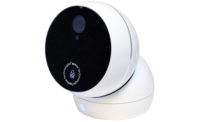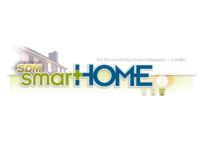Wireless Home Networks
Integrators Achieve Seamless Wi-Fi Coverage in Large Spaces

This article also contains "Projects in the News" |
Two different residential systems installers tackled the challenge of providing perfect wireless coverage in residential spaces. While any wireless project can be a challenge, these two projects both involved overcoming the added complication of designing seamless coverage in massive spaces: a 10,000-square-foot home and a 5,500-square-foot, three-story town house with an added 1,500-square-feet of living space outdoors on the bank of the river. Both installations used products from Pakedge Device & Software, Foster City, Calif., a provider of wireless and networking technology products, to design the reliable wireless systems their customers were looking for.
A 10,000-Square-Foot Wi-Fi Project
The first integrator, Vision Systems Automation, Cypress, Calif., is focused on expert craftsmanship in designing and installing home theaters, wireless home networks, conference room systems and more.
“A customer has to feel completely comfortable with an installation and find it easy to use and enjoy,” noted Neal Edmiston, owner of Vision Systems Automation. “We have to make sure that everything works together seamlessly — no glitches, no problems. That’s why for every project, we only work with the best equipment available.
“We are doing more wireless home networks, and they are getting more complex,” Edmiston continued. “One of our latest installations was in a 10,000-square-foot home. The client wanted continuous wireless service throughout the house. He wanted every family member to be able to walk around the house with their iPad without having to constantly reset their wireless network access.”
The layout of the house and the size of the property presented challenges that would not be encountered in a smaller installation. “One of the first things we had to do was to create a heat map of the wireless coverage,” Edmiston pointed out. “This involved putting up a wireless device or devices in the home, and then walking around the house with a laptop running a software program that measures signal strength at various locations. The program then gives you a visual indication of wireless strength — and the trouble spots — on the home’s floor plan.
“Pakedge helped us create a heat map of the customer’s home, and then determined the best placement for the wireless access points (WAP) and the number of WAPs we needed,” Edmiston said.
After further consulting with Pakedge, Edmiston and his team elected to use the Pakedge WAP-VKIT/ABGN [wireless access points], used in conjunction with the CTL-W5N wireless virtualization management controller.
In order to have so many WAPs function together seamlessly, Edmiston decided to use. Pakedge’s residential cell technology. This technology enables multiple wireless access points in a large home network to function as a single “virtual” wireless access point and enable seamless Wi-Fi roaming for an iPad, touch panel, VoIP Wi-Fi phone or other portable device.
In standard home networks with multiple WAPs, when a person moves from the coverage area of one wireless access point to another, there is typically an interruption in service as one WAP “hands off” to another. The result is an interrupted video stream, phone call or data stream, or lost commands from a touch panel. The Pakedge WAP-VKIT/ABGN and the CTL-W5N controller took care of this concern by linking the operation of all the wireless access points in a network together so they appeared as a single WAP (and MAC address) to a wireless device, and eliminate the need for any handoffs.
Because the wireless controller virtualizes the entire wireless environment for the clients (i.e. laptops, iPads, touch panels, etc.), a wireless client sees only one WAP, even though there are many WAPs installed. In the virtual cell environment, each client remains connected to a single virtual WAP as the client moves about the network. From the client’s point of view, it’s as if the WAP is moving along with the client in order to stay in range — wherever the client goes, the WAP follows. Because the client sees a single WAP and it moves with them, it never needs to initiate a handoff as in other WI-Fi Systems.
“The Pakedge system was the only one we could find that would enable the handoffs through the wireless access points and not have the mobile devices drop off or lose the signal. That was the homeowner’s number one concern, and the Pakedge residential cell technology did exactly what was required,” Edmiston said.
Indoor/Outdoor Wi-Fi Coverage

|
The AV Awakenings staff has completed projects across the Pacific Northwest, specializing in the design and installation of integrated whole-house audio/video, home theater, security, lighting control and HVAC systems with an added focus on green technology and custom touchscreen interfaces.
The second installation, by Audio/Video Awakenings, LLC (A/V Awakenings) of Lake Oswego, Ore., involved installing a Crestron home automation system in a 5,500-square-foot, three-story town house located on a steep side of a riverbank. “Because we were doing a large Crestron DM (digital media) system, the client had very specific requests for the home’s network and Wi-Fi performance,” noted Bill Reynolds, who founded the company in 2009 with Brent Christian and Marc Malek. “The client wanted the option to control the system via an iPad and iPhones from anywhere in the home, as well as from touch panels. We felt that the appropriate way to go was with enterprise-class networking components to ensure that every thing would perform the way we — and the client — expected,” Reynolds explained.
An unusual aspect of this installation was that the home had about 1,500-square-feet of living space outdoors on the bank of the river — a beautiful setting where the homeowner spends a lot of time.
“The client wanted complete Wi-Fi coverage for this outdoor area that would accommodate both control of the Crestron system and high-bandwidth streaming audio/video, not just wireless Internet, and being asked to cover a large outdoor area was a first for us,” Reynolds said.
AV Awakenings determined that the three floors of indoor coverage and the outdoor coverage should all be part of the same network and chose components from Pakedge including the RB Kit preconfigured router and security appliance, two switches (an SW24GB 24-port gigabit switch and an SW8-4PB 8-port fast Ethernet PoE switch), two WAP-C3N in-ceiling ultra-high-throughput wireless-N access points and a WAP-O3G outdoor ultra-high-power wireless access point.
“Using the WAP-O3G outdoor wireless access point just made obvious sense for this project,” said Reynolds. “It’s tailor-made for outdoor applications with its rugged, weatherproof design and it integrated perfectly with the rest of the Pakedge system and the Crestron components. Its performance is flawless over the entire coverage area,” Reynolds shared. Flawless coverage is the goal of every Wi-Fi installation, big or small.
PROJECTS in the News
Bosch announced that the company PT Pelabuhan Indonesia 1, which specializes in handling containers for international and domestic transportation in many ports in Indonesia, selected Bosch Security Systems to provide security and safety equipment.
Installer PT. SensorLink Yumitaro Indonesia brought the following systems into the seaport: the Praesideo digital public address and emergency sound system, Dinion and AutoDome cameras, and the video management system from Bosch (BVMS). To protect the pier, the intelligent video analysis (IVA)-enabled cameras provide advanced detection functions ranging from head detection to trajectory tracking. In addition, the AutoDome cameras are vandal-resistant and weatherproof, enabling them to handle the seaside conditions.
***
Morse Watchmans’ system is being used by United Airlines Jet Rebuild and Test Facility in San Francisco. At the facility where United brings its jets for rebuilding, each mechanic is provided with the specific tools and test equipment needed for the job at hand. The items, some valued in price between $10,000 and $20,000, are kept in locked toolboxes located in assigned areas relating to the project. The shop uses the integrated Morse Watchmans KeyWatcher key control system to store the keys for the toolboxes and to enable complete control of who has access to individual keys. The facility uses one 96-key and three 48-key KeyWatcher cabinets.
***
The CyberLock system from Vitex, Corvallis, Oregon, helps secure access to Seattle Public Utilities’ 12,500 acre land that supplies water to 1.4 million people in the greater Seattle area. Seattle Public Utilities (SPU) uses the CyberLock system of electronic locks and programmable keys to track multiple personnel and control access to physical assets. SPU selected CyberLock to secure all the entrances to the watershed that could not be serviced with automated gates due to no available power and communication lines. Since the initial installation, SPU has expanded the CyberLock system to include the 12,500-acre Tolt River Watershed due to similar challenges.
***
HID Global, Irvine, Calif., announced it has been selected to supply the U.S. Department of Defense (DoD) Defense Manpower Data Center (DMDC) with additional FARGO® HDP5000-LC ID Card Printer/Encoders that include customized enhancements for large government project requirements as well as a comprehensive set of Genuine HID services. The primary use of the HDP5000 printer/encoder is to support the DoD’s Common Access Card (CAC) program, one of the largest printing programs in North America with more than 3 million technology cards produced annually.
The U.S. Department of Defense has utilized HID Global’s High Definition Printing™ (HDP®) technology for more than 10 years. It adopted the advanced FARGO HDP5000-LC printers in 2007 and has selected the printers for follow-on purchases in 2012 to complete the update of the remaining DMDC mobile and shipboard CAC personalization systems. The HDP5000-LC is being sold and supported by system integrator Telos Corporation of Ashburn, Va.
***
Hueytown High School is one of the newest schools in Birmingham, Ala., Jefferson County School System. The 280,000 sq. ft., two-story building can accommodate 1,200 students. To help protect these students and staff in the case of an emergency, school officials and the building’s architectural firm, Lathan Associates, required egress pathways to provide both audible and visual signals. As a result, fire system designer, Stewart Engineering, included System Sensor’s ExitPoint Directional Sounders in its design to guide occupants to safe exits, even in little-to-no visibility.
***
Delta Scientific, a manufacturer of counter-terrorist vehicle control systems used in the United States and internationally, announced that it is manufacturing and installing 50 custom-design, bullet-resistant guard booths, K4-rated swing gates, barriers and bollards for the refurbishment of the San Ysidro Landed Port of Entry (SYLPOE), the busiest land port in the world. Located between San Diego and Tijuana, the port processes an average of 50,000 northbound vehicles per day, the most of any landed port in the world.
Looking for a reprint of this article?
From high-res PDFs to custom plaques, order your copy today!









